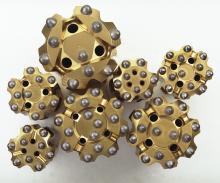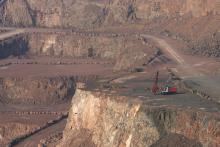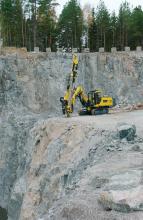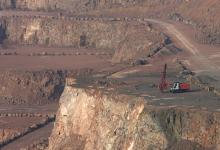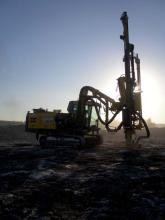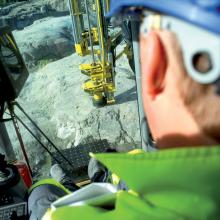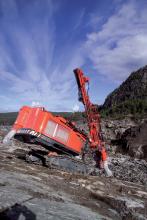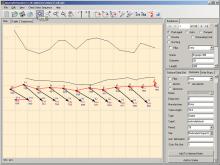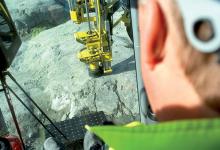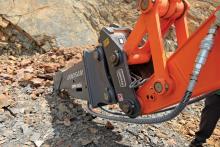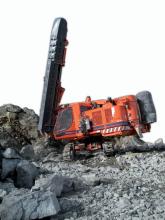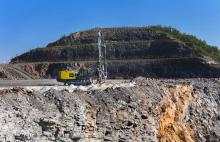
Advances in drill rig design and automation are helping to improve efficiency of drilling operations in European quarries, but more is yet to come. Claire Symes reports
Demand for better efficiency and higher penetration in European quarries has changed the type of drilling methods used over the last few decades. But now even these 'newer' techniques are being advanced with innovative technology to further improve productivity.
The latest surface drilling rigs available to the quarrying market feature more automation and communication technology than ever before. But according to drilling industry expert Kurt Strömback, further advancements will bring greater automation of the drilling process.
"Existing automation on drilling rigs has brought greater efficiency but more is possible," said Strömback, who recently retired from a 40 year career in the drilling sector and most recently worked as a product manager for
"Currently available top hammer drills are designed to operate in an automatic mode where the operator sets the hole depth and then the machine takes over. This technology will allow most sites to drill one or two extra holes per shift. But the main limitation of these systems is that they do not completely automate the drilling process - techniques to pick up the drill rod are not yet available.
"I think within the next five years we will see the first systems of this type on the market. There is no technical limitation to having such systems today; the difficulties come from mechanical and research and development capabilities, but these are not insurmountable.
"With the addition of GPS to drilling rigs, such as Atlas Copco's SmartRig, to help locate the next drill hole now becoming accepted in the quarrying market, I can see that within the next 10 years
such systems will be combined with the automation to enable the rig to track itself from hole to hole, collar the position, drill, pull back and move onto the next position by itself." According to Strömback, the other issue affecting the rate of introduction and adoption of automation is the number of different drilling techniques that are currently used in Europe. "Each system requires its own R&D to find a fully automated operation that works - it's a question of time and money," he said.
Drilling options
In Europe, quarry operators either use hydraulic top hammer drilling, down-the- hole hammer methods or the Atlas Copco technique and each has its advantages.
Until 20 years ago or so hydraulic top hammer drilling was quite new and use of pneumatic techniques was more widespread. According to Strömback, the move from pneumatic rigs to hydraulic ones was a significant change for the European sector. "Pneumatic rigs are simpler but less efficient," he said. "They are still widely used in Asia but there is a gradual change even is less developed markets towards the benefits of hydraulic rigs.
"One of the biggest factors driving this change is the lower fuel consumption of hydraulic systems - using only 25% of the fuel needed per metre by a pneumatic rig. The higher penetration rates offered also enable more metres to be drilled per shift - the hydraulic system can be three to four times faster than the pneumatic method. Switching from pneumatic to hydraulic allows quarry operators to replace three or four rigs with just one." The Atlas Copco technique separates the rotation from the impact by using an outer drill tube with the rods inside. Strömback said that this provides a stable transfer of energy with fewer losses of power. "Using a drill tube also means that less compressed air is needed for flushing, so more of the rig's power can be used to drive the drilling process," he said. "As a result the drilling process with the Atlas Copco technique is slightly faster than with top hammer methods." Down-the-hole hammer methods are common in the UK and Central Europe and maintain popularity through a combination of the simplicity and the quality of the holes the technique can produce.
Deviation
The choice of drilling technique may be influenced by cultural preferences around Europe but the design of the quarry and type of rock will also dictate the approach.
"Top hole techniques usually have a tendency to slight deviation after 8 or 10m depth," said Strömback. "In some quarries with small bench heights, this may not be a problem, but in Sweden bench heights of 40m are not uncommon, so top hole methods are not well suited to this market.
"The choice of equipment will affect the quarry lay out and the wrong choice of drilling rig could limit the full utilisation of the quarry. Something as simple as the carousel capacity on the rig may dictate the bench height that can be achieved. Although it is possible to manually add extra lengths of drill string, it involves time consuming and potentially hazardous heavy lifting."
Environment
While automation is set to continue improving efficiency over the next decade or so, the drilling industry also has some other issues to address.
"The question in Europe is, to what extent will continuous mining techniques take over from drilling and blasting in quarries, particularly in softer rock? Milling or ripping techniques are beginning to find favour in the softer formations, particularly near to local centres of population." The issue of noise has led to another development for drilling rigs - mufflers. Originally developed for drilling operations on construction sites in city centres, Atlas Copco, and more recently
"The Atlas Copco system reduces noise by 10dB(A)," said Strömback. "Without NoiseGuard the noise levels are about 55dB(A) at 1400m, but with the system attached, the noise level drops to 55dB(A) at 400m, significantly reducing the distance over which the noise can be heard."
Use of such systems is allowing some quarries close to residential developments to continue with drill and blast operations where without the system they would either have to close the quarry or look to other less efficient methods of extraction.
Production of dust and its collection is another factor which drilling equipment manufacturers are looking to address. Current options open to quarry operators are heavy and cumbersome but trials are underway to find new, more convenient solutions.
Strömback is confident that new approaches to solving the problem will be available in five years. "Collecting the dust in plastic bags is not ideal as they are heavy to move and fill quickly. Using binding media can work well but not in colder climates. Nonetheless, it is something that the industry must address along with continuing to reduce noise, lower fuel consumption and improve efficiency. The answers may not be easy but they will come."

